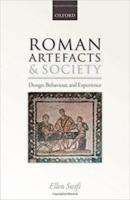
OUP (2017) h/b 305pp £85 (ISBN 9780198785262)
S. takes a number of objects—e.g. spoons, pen, glass bottles, shears, dice, boxes, finger-rings, locks and keys—and examines them under four headings: ‘Function’, ‘Behaviour/Experience’, ‘Users’ and ‘Production and Users’. The reason why these headings were chosen by S. is explained by her interest in the design concept of ‘affordances’, which she defines as ‘the perceived functional properties of an artefact that make possible, and incline people towards, specific uses. Mostly these relate to the normative use of the object’. But that use can, of course, change: as she points out, an axe may be designed to cut wood, but can also be used as a weapon. In other words, the purpose or intention of original design is not necessarily relevant to use: that comes down to human experience and behaviour in relation to the object.
The book is closely argued and highly technical. All items (well-illustrated in the book) have been subjected to an intense and detailed scrutiny, often involving the examination and measurement of features never previously taken into account e.g. the wear on the inside of a finger-ring. Practising craftsmen have also been consulted.
Some examples of S.’s findings and conclusions will give an idea of her approach. Spoons come in a variety of shapes and sizes. Shapes have been thought to indicate specialised types of use, e.g. for eating eggs and shellfish, as art-historical sources suggest, or for pouring thin streams of liquid. In fact the regular wear on the left-hand side of different types of spoon (implying a right-handed user) argue for general-purpose eating function, however specialised the apparent shape.
Square glass bottles were useful for both transport and storage and, in principle, for standard volume control. But they were blown, and square moulds into which the molten glass was set were supposed to produce standard volume sizes. But that could not be guaranteed because the thickness of the glass walls varied. Presumably the sizes were felt to be good enough, and the buyer/seller accepted that he might win on some and lose on others; or was some more accurately calibrated dispenser used to fill up the bottles? But such bottles were certainly re-used for other purposes, as the wear on the necks indicates.
The manufacture of dice from bone, usually metacarpal or metatarsal, suffered from the same problem. While small and large dice are generally pretty accurate cubes, medium-sized dice (again for technical reasons relating to original bone-size and shape) tended to be flatter; and it was on their opposing flat sides that the six and one were marked. Use these, therefore, and the best and worst scores were more likely to turn up. (Luxury dice, made from e.g. ivory or rock crystal, suffered from no such problems.) Clearly games with flatter dice would be over more quickly, both because six or one would appear more regularly and because the rolled dice stopped more quickly. Some regular dice had their corners rounded, and these would roll for longer. Were such used for divination, to allow plenty of time for prayers and incantations to affect the result?
S. sees social significance in many of her findings. She suggests, for example, that boxes which were opened in ways unfamiliar to the users would ‘foster different social experiences’ among those from ‘different cultural backgrounds’, could prompt rejection and therefore ‘help to maintain [their own] cultural traditions [about boxes]’. A travellers, however, could learn how to open them, and then show off his specialised knowledge at home ‘as a marker of status’.
Peter Jones
